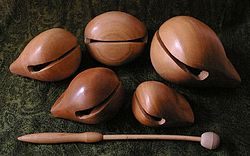Temple blocks
 | |
| Percussion instrument | |
|---|---|
| Classification | Percussion |
| Hornbostel–Sachs classification | 111.242.221 (Sets of hanging bells without internal strikers) |
| Related instruments | |
| Builders | |
The temple block is a type of percussion instrument. It is descended from the muyu, an instrument originating from eastern Asia, where it is commonly used in religious ceremonies.[1][2]
Description[]
It is a carved hollow wooden instrument with a large slit. In its traditional form, the muyu, the shape is somewhat bulbous, but modern instruments are often rectangular in shape.[3] They are generally played in sets of four or more to give a variety of pitches, in which they are also known as "tone blocks".[4] In Western music, they can be traced back to early jazz drummers where they were sometimes called "dragons' mouths" before being later adopted into widespread orchestral use.[5][6] An updated version of the instrument, known as "granite blocks", is made out of plastic rather than wood.[7]
The sound of temple blocks is similar to that of wood blocks, although temple blocks have a darker, more "hollow" timbre.[8] In their most common configuration of five, temple blocks are typically tuned to a pentatonic scale. Despite this, they are generally not considered pitched percussion.[9]
Temple blocks are often used as sound effects, such as in Leroy Anderson's "The Syncopated Clock" and "Sleigh Ride", where they mimic a ticking clock and a galloping horse, respectively.[10] They can also be used to reinforce the melody. John Barnes Chance's Incantation and Dance and Variations on a Korean Folk Song both have temple blocks introduce and double the motifs that appear within the music.[11]
References[]
- ^ Blades, James (1992). Percussion Instruments and Their History (Rev. ed.). Westport, CT: Bold Strummer. p. 391. ISBN 978-0-933224-71-1. OCLC 28230162.
- ^ Beck, John H. (2014). Encyclopedia of Percussion (2nd ed.). New York, NY: Routledge. p. 92. ISBN 978-0-415971-23-2. OCLC 939052116.
- ^ Cook, Gary (2018). Teaching Percussion. Australia: Cengage. p. 243. ISBN 9781337672221. OCLC 1100674819.
- ^ Kalani (2008). All About Hand Percussion. Los Angeles, CA: Alfred Music. p. 31. ISBN 978-0-7390-4964-8. OCLC 227032333.
- ^ Cirone, Anthony J.; Grover, Neil; Whaley, Garwood (2006). The Art of Percussion Playing (1st ed.). Galesville, MD: Meredith Music. p. 88. ISBN 1-57463-047-4. OCLC 70782197.
- ^ Vetter, Roger. "Temple Blocks". Grinnell College Musical Instrument Collection. Grinnell College Libraries. Retrieved 2022-02-14.
- ^ Kight, Jacob Marcus (2020). "The Rearrangement and Assignment of Wind Band Percussion Parts for Optimal Performance". Electronic Theses, Treatises and Dissertations. Florida State University. p. 8.
- ^ Skidmore, David (2012). "Wood / Temple Blocks: Vic Firth Percussion 101". YouTube (video). Vic Firth. 0:38.
- ^ Black, Dave; Gerou, Tom (1998). Essential Dictionary of Orchestration. Los Angeles, CA: Alfred Music. p. 246. ISBN 978-1-4574-1299-8. OCLC 1120720854.
- ^ Kruckenberg, Sven (2002). The Symphony Orchestra and Its Instruments. Edison, NJ: Chartwell Books. p. 197. ISBN 0-7858-1522-8. OCLC 51725370.
- ^ Linaberry, Robin (2021). Strategies, Tips & Activities for the Effective Band Director. New York, NY: Taylor & Francis. p. 20. ISBN 978-1-003-03419-3. OCLC 1200832393.
- Idiophones
- Orchestral percussion
- Chinese musical instruments
- Japanese musical instruments
- Korean musical instruments